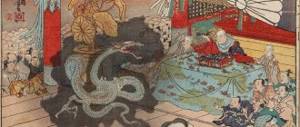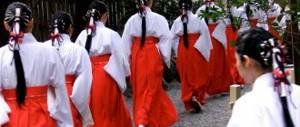Fishing in Japan
has been a vitally important industry since ancient times. And today fishing is very popular in this country. The Japanese islands are surrounded on all sides by ocean waters and therefore the main diet of most Japanese is seafood. This is the basis of Japanese cuisine. Tokyo Bay is considered one of the most popular fishing spots in Japan.
Japan has little fertile land, and agriculture is not able to meet all the needs of the population. Due to such circumstances, marine fishing in Japan has become the main way to provide people with high-calorie food. The main types of fish that are caught in the coastal waters of the Land of the Rising Sun are tuna, salmon, marlin, flounder and many other species.
Reservoirs of Japan
Map of Japan
Japan is an amazingly beautiful country that, despite its modest size, has rich natural landscapes. The largest islands are home to Japan's largest rivers and lakes.
Due to the peculiarities of the relief, the rivers of Japan are not large in size. Only a few exceed 200 km in length. The Shinano River, which spreads its fast flows on the island of Honshu, is considered the first in length. The plain through which Shinano flows is very fertile, with extensive rice fields.
The second longest and first largest basin is the Tonegawa River. For many hundreds of years, Japanese engineers were forced to carry out work adapting the basin of this river for transport needs, as well as in the fight against spring floods. In addition to shipping and fishing, it is used for rafting competitions.
On the island of Hokkaido there is the second largest river - Ishikari. It originates in the mountains and flows into the Sea of Japan. This river is the transport artery of the island and is also used for timber rafting. The lakes of Japan are different in their origin and purpose.
Lake Biwa is considered the largest, with an area of 640 sq. km. It was formed as a result of seismic activity millions of years ago and is considered one of the oldest not only in Japan, but also in the world. Lake Biwa is used as a source of fresh water for fishing and pearling, and the beautiful scenery and rich flora and fauna attract tourists from all over the world.
Many lakes in Japan occupy the craters of extinct volcanoes. These mountain lakes are located high above sea level and exist mainly due to mineral springs. For example, lakes Shinano and Asi.
In the coastal zone, on flat plains, there are lagoon-type salt lakes. This can be considered Lake Kasumigaura, which is also the second largest in Japan.
The largest rivers and lakes in Japan are the country's national treasure. As a rule, large national parks and nature reserves are located in their basin.
Fishing as one of the leading sectors
Growing fish for the Japanese is as important as cultivating rice, since the consumption of these two types of products has traditionally been the basis of the diet. Currently, fishing is in second place after rice cultivation.
In addition to growing and catching fish, large Japanese companies are also involved in the production of seaweed, as well as clams and mussels. The development of pearl fishing has also become widespread. A characteristic feature of Japanese fishing is the presence of a fairly large fishing fleet, which numbers about one hundred thousand vessels.
The next industry feature is aquaculture. Aquaculture includes fish farming in creeks or lagoons, rice fields, and mountain lakes.
Types of fish in reservoirs and features of their fishing
Fishing in Japan
The waters of Japan are rich in an abundance of fish. Of the salmon fish of the genus Oncorhynchus, the yamaba is the most common. This heat-loving species even enters the rivers of northern Kyushu. A characteristic sign of yamaba is dark transverse stripes on the body. The maximum weight of caught specimens is up to 1 kg. The usual catch of Japanese fishermen is yamaba weighing 400-600 g. Like trout, this salmon is a highly athletic fish, and many people are fond of fishing for it.
In May and June, the eastern rudd, or ugai (Leucisas brendti), the only cyprinid species found not only in fresh water, but also in the ocean, begins to rise in many mountain rivers of Hokkaido. In appearance it is very similar to ide and reaches a weight of 1.5 kg.
Flat waters are also fertile places for fishing, inhabited by carp, crucian carp, barbel, catfish, eels, minnows, pike and other species of fish.
The greatest success among anglers is carp fishing. The Japanese have been breeding it for a long time, and now many of its varieties live in the calm waters of the country, including the wild form (Ciprinus carpio) - the Japanese koi carp. Like its European relative, it is strong and offers stubborn resistance when fished. Under favorable feeding conditions, carp grows up to 13 kg, and sometimes more. They catch it, like ours, with float and bottom fishing rods using a wide variety of plant baits.
Japanese crucian carp (Carassius langsdorffii) is also an important object of recreational fishing. Mabuna loves well-warmed waters with abundant underwater vegetation and a muddy bottom. Like carp, crucian carp is widespread on all the islands of Japan, and in those reservoirs where it usually lives, mabuna also lives, and vice versa. Japanese crucian carp is omnivorous and is not averse to eating algae. In rivers it is caught with long rods at the border of vegetation, mainly with worms, various crustaceans, and snails. Mabuna reaches a weight of 2.5 kg, but smaller specimens, weighing 700-800 g, are more often caught on a fisherman’s hook.
Typical of lowland rivers and lakes of Japan and naked (Hemibarbus labeo). In our Far East, this fish is known as the gubar horse. In Japanese waters it grows up to 60 cm and weighs 3 kg. Externally, it is very similar to a giant minnow. The Japanese catch it on sandy and pebble soil with bottom fishing rods, using worms, larvae of aquatic insects and live bait as baits.
In a variety of bodies of water in the country: rivers, streams, ponds, lakes, quarries, reservoirs, irrigation canals and even in small ditches with a muddy bottom, you can find catfish. These predators have adapted to life in a wide variety of conditions, are quite numerous and are frequent prey for fishermen. They are caught on live and dead fish, frogs, worms and shellfish.
Among other predatory fish, mention should be made of the Japanese pike, which is much smaller than ours. However, its fishing is not very popular among anglers. The most commonly used bait is minnow-barbel species. The best live bait for catching many predators is the loach.
The unagi eel (Anguilla japonlca) is found in many water bodies in Japan. He is very similar to the European in both his habits; the same way in appearance and differs from it mainly in the darker border on the fins. However, if for the European eel the spawning place is precisely established - the Sargasso Sea, then for the Pacific eel it is still a mystery. There is only an assumption that it spawns in a vast expanse of the Pacific Ocean - from Taiwan to Bikini Atoll. From there, carried away by the warm current of Kuro-Siwo, small eels arrive on the shores of Japan and go into the rivers. However, to reproduce, they go to sea again, never to return. Unagi is a heat-loving fish. The best bite occurs when the water temperature remains at plus 25°. If it is below 10°, the eel stops taking the bait altogether. They catch it, as in Europe, mainly with bottom fishing rods using a worm. The rivers of Shizuoka, Aihi and Mie prefectures are especially rich in eels.
At the mouths of many rivers it is found (Muraene sox). The head of this large fish, reaching a length of 2 m, is very similar to the head of a pike. The body of the hamo is devoid of scales, and the tail is strongly compressed from the sides. It is caught with live bait at night.
Features of fishing in Japan
The most fertile time for Japanese fishermen is autumn. Both freshwater, anadromous and semi-anadromous fish bite well, and in the estuaries there are also sea fish.
It would seem that the rivers of Japan are a paradise for anglers. But it is not so. In densely populated industrial areas (the plains of Kanto and Quiney), you can often see hundreds of anglerfish wading in some “catching” place, widely advertised in the press and on television. However, most of them have very modest catches - just a few small fish. The reason for this is significant river pollution.
Some of them, like Macaws, which were very fishy in the past, have become lifeless. There are no fish in the Samida River, which flows through Tokyo, or in the Yoda River, on which Osaka stands. Osaka and Tokyo bays are also heavily polluted. Therefore, fishermen in large industrial cities (Tokyo, Osaka, Yokohama, etc.) prefer to fish in reservoirs and ponds. In them, along with ordinary carp and crucian carp, white and black carp, artificially bred in these reservoirs, are caught. Some Tokyo fishermen fish without leaving the capital - in salons where they catch carp from the pool for a fee.
In Japan, people are accustomed to fishing, one might say, from the cradle. The baby doesn’t even know how to walk, but he’s already playing with fish and crustaceans. Then the toys are replaced by live fish, which the child observes through the glass of the aquarium. A young Japanese very early begins to become acquainted with the life of fish, learn to understand their behavior, and penetrate the mysterious life of the underwater world. Perhaps this is the main reason that the Japanese are first-class fishermen, and searching fishermen who strive to improve their fishing. And sometimes they achieve phenomenal results in this field.
Sea fishing in Japan
Sea fishing in Japan is one of the most exciting forms of active recreation. As a result of this, fishermen from all over our planet often come to Japan for fishing. And as mentioned earlier, one of the most popular fishing spots in Japan is Tokyo Bay. If you want to catch tuna as a trophy, then you need to hire a specially equipped boat for catching this fish. The captains of such ships know very well the places where you can get the desired trophy.
Fishing with cormorants in Japan
Fishing in Japan with cormorants
In Japan, there is one ancient way of fishing, which today Japanese fishermen entertain tourists with. This is Japan's national cormorant fishing sport. Such fishing is carried out only at night under the light of lanterns or torches, which attract fish from the bottom.
In the vastness of the Nagara River, today fishermen often use this method of fishing. In Japanese, fishing with cormorants is called "ukai". The habitat of cormorants is huge. They are distributed almost all over the world. In China and Japan, cormorants have been used for fishing since ancient times.
In ancient times, almost the entire territory of Japan was covered with lush forests, and the entire territory of the islands was surrounded by a coastline that stretched for hundreds of kilometers. These places have always been an excellent home for river and sea cormorants.
With the onset of winter, sea cormorants migrate to the southern and central parts of Japan, with the exception of the islands of Honshu and Hokkaido, and stay there until the onset of spring warmth. As for river cormorants, they constantly live on islands in many parts of the country.
Evidence of the close ancient connection between people and cormorants is that the Japanese even have a separate hieroglyph for “cormorant”; the names of many places and even the surnames of people are also associated with this bird.
Episodes of fishing in Japan with the help of cormorants were depicted on pottery; even in the 5th-6th centuries, ancient Chinese documents also mention this method of fishing. It is also known that this method of fishing was used in 150 different places in Japan. Most likely, this type of fishing came to Japan from China long before the 5th century, just like many other crafts that came from the Middle Kingdom to the Land of the Rising Sun.
Nowadays, fishing in Japan with cormorants is used in two dozen different places in the country, but this fishery flourishes solely for the sake of attracting tourists. The most popular places where you can watch or participate in cormorant fishing are the Nagara River in the city of Gifu. The fishing season in these places lasts from the first half of May to mid-October for 158 days.
Cormorants, which are used for fishing in the Nagara River, are a marine species. They are brought at the age of 2 years to the city of Gifu from the Ibaraki coast. There they are caught and trained. Sea cormorants are considered more capable fishers than the river species. Usually the cormorant dives and underwater grabs a fish with its beak, having surfaced, the bird throws the prey so that it falls into the beak head first and swallows it. This bird has a hook-shaped beak that opens at an angle of up to 80 degrees; it is capable of swallowing fish up to 40 cm in length. A special hemp bandage is placed around the cormorant’s neck to prevent fish from getting into the bird’s stomach. When a fisherman notices a swelling on the neck of a cormorant, he squeezes the bird’s throat with his hands so that it gives up its prey.
But the bandage that clings to the cormorant is in a fairly loose state and small fish are able to fly into the cormorant’s stomach, so the bird will not remain hungry. If the bandage is tightened, the cormorant will, of course, catch more fish, but this way it will get tired faster and its lifespan will be shortened. Cormorants hunt all year round, and their lifespan rarely exceeds 5 years. But in places where fishing with cormorants is practiced, these birds can live up to 15 and even 20 years. Fishing cormorants are well cared for, and they are always given the opportunity to have a good rest.
Fishing in Japan with cormorants begins after dark. On the boat, the fisherman lights a torch and its light attracts fish and at the same time illuminates the way. The team leader uses thin leashes to hold the bird in a place illuminated by a torch. The person who holds the cormorants with leashes is called u-sho; high-level professionals can hold up to 12 cormorants. The spectacle of catching fish with cormorants is very exciting. The art of wu-sho evokes real admiration among many people, because manipulating a whole flock of diving birds that return back with fish is very spectacular.
Of course, it is very interesting to look at this spectacle, but sea fishing in Japan for various types of fish is no less interesting and most fishermen come to this country to fish in the sea.
Ukay fishing without gear
And over the long years of Japanese history, it has not undergone any changes. Ukay is fishing without gear, using trained cormorants. The method is widely used on Japanese rivers, and is fished from May to October, at night, by torchlight, from long and narrow boats (usually 13 m long and a little more than a meter wide).
On them, Japanese fishermen deftly and with great skill overcome fast currents and even small rapids. Usually a whole flotilla (6-8 boats) takes part in the ukay. There are four people in each boat, two of them control the birds, and two control the boat. The rowers do not take any precautions, and even knock their oars on the side: the noise attracts the aya.
Each cormorant has a leather ring on its neck that prevents the bird from swallowing its prey. A cord is attached to the same ring, with the help of which the bird is controlled. As soon as the fisherman notices that the cormorant's neck is swollen, he forcefully drags it into the boat, forces it to open its powerful beak and release the fish.
An experienced fisherman controls 10-12 birds, an assistant usually has less - 5-6 cormorants.
Ukay is a colorful sight. Wire baskets with burning brush hanging on the sides of the boats brightly illuminate the fishing area. The water is churning with large black birds diving here and there. And at the bow of each boat stands the “lord of the birds” in a black cap, a black jacket and a rustling straw skirt.











